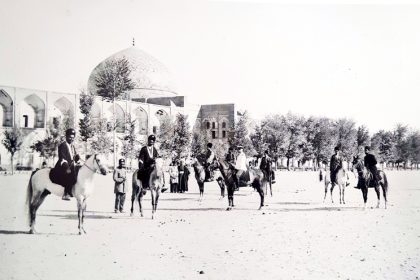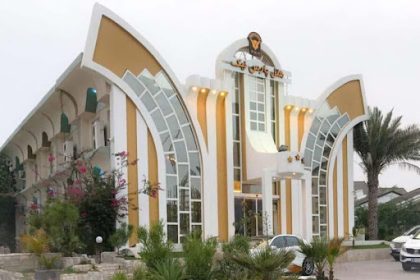Stepping into the biggest and oldest palace in the whole world makes one feel like being in an animation. To experience this feeling, I suggest you go to Topkapi Palace in Istanbul. The building, which was the residence of ambitious courtiers and cunning eunuchs during the Ottoman rule, is now one of the must-see places in Istanbul.
In this article from Alibaba Tourism Magazine, I invite you to visit Istanbul’s Topkapi Palace and provide you with a guide to visit this historic and fascinating palace.

Where is Topkapi Palace?
Topkapi Palace is located in the city of Istanbul, Turkey, on the highest point of the foothills and facing the Sea of Marmara.
What is the most important feature of Topkapi Palace?
This palace is the biggest and oldest palace in the whole world.
What is the easiest way to reach Topkapi Palace?
The easiest way to go to Sultan Mehmed Palace is to use the public transportation system (tram, metro or bus) that goes there from the European part of Istanbul.
Do I have to pay an entrance fee to visit Topkapi Palace?
Yes, the ticket to Topkapi Palace is 100 liras to visit the harem and 80 liras to visit the Church of Aya Irene.
When is the best time to visit Topkapi Palace?
Spring and summer are the best time to go to Istanbul and see the beauty of Topkapi Palace.
Where is Topkapi Palace?
This charming and enchanting palace is one of the most beautiful sights in Turkey, which is built on the highest point of the foothills, facing the Sea of Marmara. It takes about 50 minutes to go from Istanbul Ataturk Airport to Topkapi Palace. Other important tourist attractions such as Sultan Ahmed Mosque, Hagia Sophia and Basilica Reservoir are also built near this palace.
Topkapi Palace location on Google Map

Photo from: Google Maps site
The best time to visit Topkapi Palace
Be careful not to plan to go to Istanbul’s Topkapi Palace on Tuesdays, because this palace is closed on Tuesdays, but the rest of the week is ready to welcome you. Topkapi Palace is open from 9 am to 5:30 pm.

Photo from: Google Maps site
Since Topkapi Palace is surrounded by gardens and green areas, the spring season is more spectacular than any other time. And that’s exactly why this season Istanbul is more crowded and everything is more expensive; So, if you want to see Topkapi Palace in a quieter and cheaper time, the cold seasons are the best option.
Access route to Topkapi Palace
The easiest way to go to Sultan Mehmed Palace is to use the public transportation system (tram, metro or bus) that goes there from the European part of Istanbul. Gulhane and Sultan Ahmed stations are the closest stations to Topkapi Palace Museum, which will take you there within five minutes.

Photo from: Google Maps site
Architecture of Topkapi Palace
The architectural style of Istanbul’s Topkapi Palace is nested, and you have to pass through four courtyards to see its different parts. I suggest that upon entering this palace, you first look up to be enchanted by its architecture and ceiling carvings. This is where you wish your ceiling was like this so that you can fall asleep staring at it every night.

Photo from: Google Maps site
Different parts of Topkapi Palace
If you want to visit this historical palace and historical attraction of Istanbul, it is better to familiarize yourself with the different parts of this palace before that.
– The first yard
The first courtyard, which is also called the outer courtyard, is the largest courtyard of this palace. During the Ottoman Empire, any unarmed person could enter the palace through this courtyard and the imperial gate. The open space of this courtyard was probably a place for various religious and cultural ceremonies. You can see and enjoy the works of artists, painters, architects and craftsmen in every corner of this courtyard.

Photo from: Google Maps site
– The second yard
The second courtyard or the middle gate led to the second court of the palace, which was the place for the imperial administration. During the Ottoman period, this gate was only for the Sultan and his family to pass through, who entered it on horseback, but the rest of the military and ministers had to dismount and then pass through the gate.

Photo from: Google Maps site
Inside the second courtyard, there are three important areas that you should not miss; The first is the royal kitchen, which is located on the right after entering; This section also has the largest collection of china in the world.

Photo from: Wikipedia site
The second place is the Imperial Parliament Council Hall between the 15th and 19th centuries. The last one is the sultan’s harem, that is, the place where the wives of the sultan’s family lived. After seeing these sections, you can enter the third courtyard garden.
– The third yard
The third courtyard, which is also called the Gate of Happiness, was for the Sultan’s private residence, where a school was also built, and many great celebrations were held in this gate. But no one had the right to pass through this gate without permission, and only the Sultan himself and his family members had the right to travel through it.

Photo from: Wikipedia site
A series of strict rituals were used to enter this yard; For example, no one had the right to make eye contact with the sultan and they should not talk to him directly. They had to lower their heads and look at the ground, and to talk to the Sultan, they had to say their words to his translator.

Photo from: Google Maps site
There are two other important parts about this section that you should not miss; One is the religious section where you can see the properties of the prophets, the old parts of the Kaaba in Mecca and religious decorations. The second most important part is the imperial treasury, when you see it, you understand the power and glory of the sultans who rule over a third of the world.
After seeing these parts, you can enter the fourth courtyard; A place that is very similar to heaven.

Photo from: Wikipedia site
– The fourth yard
The extension of the third courtyard reaches the fourth courtyard of the palace; A place full of terraced gardens, pavilions and magnificent mansions. Each of these rooms was for a specific task; For example, the circumcision room of the Shah’s sons, the Baghdad mansion, the Yerevan mansion, the Sufi mansion, all of which overlook unique views.

Photo from: Wikipedia site
One of the most famous buildings in the fourth yard is the golden and bronze iftar pavilion, where the sultans would break their fast there if Ramadan was in the summer. Many Ottoman sultans were fond of flowers and gardening, and for this reason, the gardens of the fourth courtyard are full of tulips; In the same way as it was during the reign of the Ottomans.
– harem
The harem was built by Shah Murad III. To go there, you have to enter it from the second courtyard. At that time, in order to enter and leave the harem, the residents of the palace had to pass through the royal gate, which was protected and controlled by eunuchs. Eunuchs were slaves who were bought from the market and circumcised before puberty; Their main duty was to maintain and protect the harem in exchange for a salary.

Photo from: Wikipedia site
– Islamic Museum
Another attraction of Istanbul’s Topkapi Palace is the hall where religious objects related to the era of the Prophet and Mecca are kept. At that time, Sultan Selim used to travel to places like Cairo, Medina, Mecca and Baghdad to collect these valuable objects and transfer them to his palace in Istanbul.

Photo from: Google Maps site
The interesting thing about this hall is that during all the years of the Ottoman rule, the Quran was read inside it; Even now, when the museum is open, you can hear the recitation of the Quran.

Photo from: Google Maps site
Majidieh Palace
This palace was built by the governor of Egypt to show loyalty to Sultan Abdul Majid Osmani around 1845 and gave it to him as a gift. This palace was mostly used for hunting and meetings of Ottoman sultans; But no one lived in it for long.

Photo from: Google Maps site
After the end of the World War, this building was left to itself and after some time it became an orphanage. A little later, it became a place for refugees after the war. Years later, it was rebuilt and now it is considered a part of Topkapi Palace Museum.
Sultan Ahmed III Library
Imagine entering an old library with a unique architecture, where there are about 18 thousand old books. Walking in this space, you will smell the smell of old papers and the smell of dusty pages of these books. These books are seen in various miniatures, paintings and manuscripts.

Photo from: Wikipedia site
Apart from this valuable library, the largest collection of paintings in the world is kept in this library, which includes the works of the most prominent painters of the Safavid era. Even in this library, you can find thousands of books written in Persian and related to the Safavid era.
Amenities of Topkapi Palace
Istanbul Topkapi Palace has the usual access ways to enter; But due to its cobbled floor, it may be a bit difficult for those who enter the palace with a wheelchair. There is no parking in the palace itself; But you can park your car outside the palace. Do not forget that photography is prohibited inside the museum halls.

Photo from: Wikipedia site
History of Topkapi Palace
Istanbul’s Topkapi Palace was built a few years after the conquest of Constantinople by order of Sultan Mehmed II. He moved to this palace in 1478 and stayed there until his death. During the six-hundred-year Ottoman Empire, about thirty sultans managed the affairs of the country from inside this palace and added to its size and architectural style.

Photo from: Google Maps site
Istanbul’s Topkapi Palace, which is full of magnificent mansions and palaces in Istanbul, was the home of the Ottoman sultans for nearly four centuries and was opened as a museum about a century ago.
A 500-year-old building that is really worth seeing not only for its magnificent architecture but also for its undeniable cultural and historical values. This building is the first palace built in the Ottoman period and is one of the UNESCO World Heritage Sites. The most important reason for attracting tourists here is that it is known as the largest and oldest palace in the world.

Photo from: Google Maps site
Istanbul’s Topkapi Palace is also of special importance to Muslims; Because souvenirs of the Prophet are kept in this museum. Istanbul’s Topkapi Palace was built by Sultan Mehmed II from 1466 to 1478 on a small peninsula. This building was known as the political center of the Ottoman Empire for about four centuries until the construction of Delma Baghche Palace.

Photo from: Google Maps site
In general, since the first day of construction of Topkapi Palace in Istanbul, more than 4 thousand people lived in it. It took nearly four centuries to add Delmabaghche Palace to this building.
The reason for naming Topkapi Palace
Istanbul’s Topkapi Palace was called the New Palace of Amera when it was built. Sultan Muhammad II chose it as the new imperial palace with the aim of creating a distinction between this palace and the old palace of Constantinople. With the passage of time and the arrival of the 19th century, the name of Yen Kakh was changed to Topkapi (Tupqapo in Turkish).

Photo from: Google Maps site
At that time, war cannons were displayed in front of the gate of this palace; For this reason, it was called Topkapi, which means the gate of balls.
Recommendations for visiting Topkapi Palace
The important point when visiting the beauty of Topkapi Palace in Istanbul is that the use of carriages in the palace is prohibited. And another important point is that it is necessary to wear clothes, especially when visiting the religious and sacred artefacts section; So try to avoid wearing summer dresses or short skirts.

Photo from: Google Maps site
Most importantly, don’t forget to take a camera so that you can take a memorable photo of the beauty of this palace. But taking pictures inside the halls and museums of the palace is prohibited, and you can only take pictures of the outside space and courtyards. And we also said that the museum is closed on religious and official holidays.
Sightseeing places near Topkapi Palace
After visiting Topkapi Palace, instead of going away from that area immediately, it is better to visit the sightseeing places of Istanbul around this palace.
– Hagia Sophia Mosque
Hagia Sophia Mosque or Holy Wisdom Mosque is one of the most important historical buildings with unique architecture in the world. This mosque, which is also called the Church of Divine Wisdom, is actually a Christian church that was built in the 6th century AD during the Byzantine Empire.

Photo from: Google Maps site
After several centuries, this church was changed to a mosque and a museum; At the first step, upon entering this building, you will notice the religious changes of the region over the years; For example, the mosaics are related to the Christian era, but on the other side of the hall you can also see Islamic minarets and inscriptions. This mosque and its surrounding historical monuments were registered in the UNESCO World Heritage.

Photo from: Google Maps site
To go to this mosque, you have to go to Ayasofiya square in Sultan Ahmed neighborhood. Visiting hours of the Hagia Sophia Mosque are from 9 am to 7 pm in the spring summer season and from 9 am to 3 pm in the autumn and winter seasons, all days except overnight and Monday.
Hagia Sophia Mosque is near Topkapi Palace in Istanbul and you can visit it after visiting Topkapi Palace by walking for a few minutes.
– Basilica reservoir
This underground building was built by order of Emperor Justinianus in 532. This buried palace with its marble columns is the largest Byzantine cistern in Istanbul. You will be surprised to see the symmetrical architecture and carvings on the columns of this building.

Photo from: Google Maps site
Basilica reservoir is in front of Hagia Sophia Mosque and near Topkapi Palace Museum. So, after seeing the Abu Sufiya Mosque, you can also see this famous historical building within a few steps.
– Museum of Archaeology
If you go to the south side of Istanbul’s Topkapi Palace, you will find the Archeology Museum in the Greenhouse Park. This museum is related to ancient arts and artworks of the Babylonian civilization, which has three separate buildings. By entering this museum, you can see the ancient works related to the governments of Byzantium, Greece and Rome.

Photo from: Google Maps site
– Sultan Ahmed Mosque
Sultan Ahmed Mosque or Blue Mosque, which was built in 1617, has attracted the attention of many tourists with its amazing architecture. The elongated domes and narrow and tall minarets of this mosque may make you want to stay there for hours and just stare at the unique architecture of this mosque.

Photo from: Google Maps site
If you go to this mosque, before doing anything, look above your head so that the enchanting beauty of its architecture will surprise you. Thousands and thousands of mosaics arranged only on the ceiling of the mosque will take your heart with the combination of magnificent colors. Another beauty of this mosque is its wonderful windows. About 200 windows have been built in this building, which stunningly brings sunlight into the building.
We suggest that the first place you see after Topkapi Palace in Istanbul is this mosque; Because they are not far from each other and you only need to walk 550 meters to reach it.
RCO NEWS
















